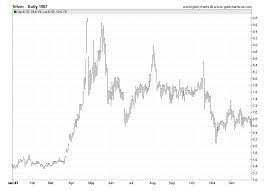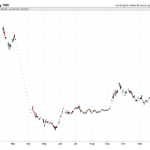The year 1997 was marked by significant fluctuations in the prices of silver, which were influenced by market demand and economic conditions. These daily price fluctuations ranged from $4.67 to $5.31 per ounce between July and December, posing both challenges and opportunities for investors interested in silver-related financial products or physical silver.
A comprehensive analysis of the silver market in 1997 is necessary to understand the factors that impacted silver prices, the trends that emerged, and the market insights that investors can draw from these fluctuations.
This article aims to provide insights into the silver market in 1997 by analyzing the daily price fluctuations, identifying the trends that emerged, and drawing market insights that can help investors make informed decisions. The article will use a data-driven and analytical approach to present an objective and impersonal analysis of the silver market in 1997.
The information presented in this article will be valuable to investors, traders, and analysts interested in silver-related financial products or physical silver, as it will provide a comprehensive understanding of the market dynamics that shaped silver prices in 1997.
1997 Silver Prices
The daily silver prices in 1997 fluctuated significantly, with prices ranging from $4.22 oz to $6.27 oz. December 19, 1997 had the highest price of $6.09 oz, while October 17, 1997 had the lowest price of $4.92 oz. These fluctuations indicate volatility in the market during that period.
A historical comparison of the daily silver prices in 1997 reveals that prices were generally stable in July and August, but started to increase in September and October. Prices increased significantly in December.
These fluctuations in silver prices can be attributed to market demand and global economic and political events, highlighting the importance of understanding silver prices and market trends for investors.
Daily Price Fluctuations
During the second half of 1997, traders witnessed a remarkable surge in the value of silver, with its worth reaching unprecedented levels in December.
The daily silver prices from July 16 to December 31, 1997, show that in September and October, the prices started to increase steadily, with a few fluctuations. However, in December, the prices increased significantly, reaching a peak of $6.09 oz on December 19, 1997.
This sudden price surge can be attributed to several factors such as increased demand, global economic conditions, and political events.
Market analysis suggests that the demand for silver was high in the latter half of 1997, with investors looking to diversify their portfolios and hedge against inflation. Additionally, the Asian financial crisis and the economic instability in Russia led to increased demand for precious metals such as silver.
The price volatility of silver during this period highlights the importance of understanding market trends and economic conditions when making investment decisions. By analyzing historical data and staying up-to-date with current events, investors can make informed decisions about the silver market and potentially benefit from its fluctuations.
Silver Market Insights
Investors can gain valuable knowledge about the precious metal industry by analyzing historical data and staying informed about global economic and political events. The silver market is influenced by a variety of factors, including supply and demand, economic conditions, and geopolitical events. Understanding these factors can help investors make informed decisions about investing in silver.
One key factor that influences the silver market is industrial demand. Silver is used in many industrial applications, including electronics, solar panels, and medical equipment. When there is strong demand for these products, the demand for silver also increases, which can drive up prices. Additionally, investment strategies can also impact the silver market. Investors can purchase physical silver or invest in silver-related financial products, such as exchange-traded funds (ETFs) or futures contracts. The buying and selling activity of these investors can also affect the overall demand for silver, which can impact prices. By staying informed about these trends and market insights, investors can make informed decisions about investing in silver.
| Factors Affecting Silver Prices | Impact on Silver Prices |
|---|---|
| Supply and Demand | Fluctuations based on supply and demand imbalances |
| Economic Conditions | Economic growth and inflation rates can impact prices |
| Geopolitical Events | Political instability or conflict can cause price fluctuations |
| Investment Strategies | Buying and selling activity of investors can impact demand and prices |
| Industrial Demand | Strong demand for silver in industrial applications can drive up prices |
In conclusion, understanding the silver market requires analyzing historical data and keeping track of global economic and political events. Investment strategies and industrial demand are two key factors that can impact silver prices. By staying informed about these trends and market insights, investors can make informed decisions about investing in silver.
Frequently Asked Questions
What were the primary factors that influenced silver prices in 1997?
Global economic factors and mining production were the primary influencers of silver prices in 1997. Prices ranged from $4.67 to $5.31 oz and fluctuated due to market demand. Understanding these factors can aid in making informed investment decisions.
How did the demand for industrial silver affect the market in 1997?
The demand for industrial silver in 1997 was influenced by production fluctuations. This affected the market, causing prices to vary due to global economic and political events, and investors’ decisions to purchase physical silver or invest in silver-related financial products.
Were there any major geopolitical events that impacted silver prices in 1997?
Political instability, including the Asian financial crisis and tensions with Iraq, had a significant impact on silver prices in 1997. Investor sentiment also played a role in price fluctuations, particularly in the latter half of the year.
What were the key differences between the physical silver market and silver-related financial products in 1997?
The physical silver market in 1997 involved buying and selling physical silver, while silver-related financial products included investing in stocks, futures, and options. Investment demand was driven by speculation, while industrial demand was based on the metal’s use in manufacturing.
How did silver prices in 1997 compare to historical trends and future projections for the market?
Comparing trends and analyzing fluctuations in silver prices is crucial for exploring market insights. Looking at historical data and future projections can provide objective, data-driven analysis for investors to make informed decisions.





